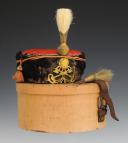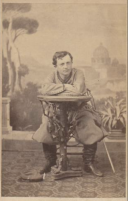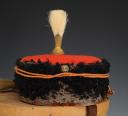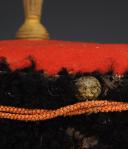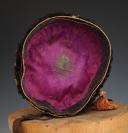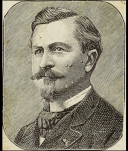
CAPTAIN Olivier LE GONIDEC's TALPACK from the PONTIFICAL ZOUAVES, model 1867-1869, Second Empire. 32198
Sold out
CAPTAIN Olivier LE GONIDEC de TRAISSAN'S TALPACK OF THE PONTIFICAL ZOUAVES, model 1867-1869, Second Empire. 32198
Made of cardboard covered with an astrakhan band. Cap, 19 cm x 16 cm, covered in scarlet cloth. Attached to the front of the band is the insignia of the Papal Arms in stamped gilt brass: two crossed keys surmounted by the mitre (H 7 cm x 9 cm). Cockade in silvered metal, Ø 4 cm, with a central part inlayed in yellow lacquer. At the top of the band, on the right side and at the back, is a stamped brass lion's head (approximately 1.7 cm high x 1.5 cm wide), with a lower hook holding a double orange passementerie cord ending on the right with a tassel of soft fringes.
White horsehair plume mounted on a metal rod placed in a gilt brass sheath, with a gilt brass tulip. Visible height of the white horsehair 6 cm, height with the tulip 11.5 cm, total height 16.8 cm.
Second white horsehair plume mounted on a brass wire, garnished at its base with the upper part of a gilt brass tulip.
Wooden transport box closing with a leather strap and a tinned iron buckle.
France.
Second Empire.
BIOGRAPHY:
Olivier-Marie-Mériadec Le Gonidec, Count of Traissan, born at the Château de La Baratière in Vitré on February 24, 1839, and died in Paris on January 18, 1912, was a French military officer and politician. He came from an aristocratic family originating from the area of Rennes. Son of Alfred Marie-Mériadec Le Gonidec de Traissan (1807-1889) and Claire-Marie-Louise du Plessis d'Argentré, he became known early on for the ardor of his royalist and Catholic sentiments.
He enlisted in Rome under matricule 55 on May 29, 1860, returned to service on June 1, 1860, and was assigned to the Franco-Belgian Tirailleurs, a unit of volunteers formed to defend the Papal States. Appointed corporal in the pontifical zouaves on September 3, 1860 (matricule 10). He climbed through the ranks: sergeant on January 1, 1861; sub-lieutenant on March 19, 1861; lieutenant on August 11, 1862; he was appointed captain on January 1, 1867. He participated in the campaigns of Rome in 1860, 1867, and 1870, engaged in the battles of Castelfidardo (September 18, 1860), Ponte-Correze near Rome (January 28, 1861), and Mentana (November 3, 1867), as well as the siege of Rome in 1870. Released from the oath of loyalty to the Holy See on September 20, 1870.
Returning to France during the Franco-Prussian War campaign of 1870-1871, he joined the volunteers from the West, integrating with his rank of captain on October 10, 1870, and was appointed battalion commander on October 16, 1870. During the Franco-Prussian War of 1870, he joined the Legion of Volunteers of the West and participated in the campaign of the Loire in Charette's corps. He took part in the battles of Cercottes (Loiret) on October 10, Brou (Eure-et-Loir) on November 25, and Loigny (Eure-et-Loir) on December 2, 1870.
Upon returning to civilian life, he maintained close ties with monarchist circles and former pontifical zouaves. A municipal councilor of Vitré, he ran as a monarchist candidate in the legislative elections of 1876, and was elected on March 5, in the second round of voting, as deputy of Ille-et-Vilaine with 9,997 votes (out of 14,803 voters, 19,692 registered), against 4,841 for Mr. de Montluc. He sat on the far right, was one of the secretaries of the Chamber, consistently voted with the minority, and supported the government of the Seize-mai against the 363 majority. Re-elected on October 14, 1877, with 13,022 votes (out of 17,316 voters, 20,391 registered), against 4,237 for Mr. de Montluc, he followed the same policy as before, voted against the invalidation of right-wing deputies, against the Dufaure ministry, against Article 7, against the laws of Ferry on education, against amnesty, etc., and was re-elected in the same district in the elections of August 21, 1881, with 10,319 votes (out of 15,555 voters, 20,350 registered) against 5,142 for Ragot. An opponent of all the cabinets that succeeded in power during the legislature, he voted against the credits for the Tonkin expedition. In the elections of October 4, 1885, running on the conservative list of Ille-et-Vilaine, he failed with 59,414 votes, but regained his seat on September 22, 1889, which he held until his death in 1912. He remained in his place in the anti-republican opposition.
Upon the death of General Baron de Charette on October 9, 1911, Count Olivier Le Gonidec de Tressan became the commander of the former regiment of the Pontifical Zouaves on December 2, 1911. The Lord of La Baratière, he died in Paris on January 18, 1912, and was buried in Vitré.
Distinctions:
Knight of the Order of Pius IX.
Medal of Castelfidardo "Pro Petri sede".
Mentana Cross "Fidei et Virtute".
Pontifical Medal "Bene Merenti".
Knight of the Legion of Honor (July 29, 1871).
Olivier's brother, Paul Le Gonidec de Traissan (1840-1888), also pursued a brilliant career in the zouaves, demobilized as a battalion commander in 1870 and made a Knight of the Legion of Honor. Their first cousin, Frédéric, also a zouave, maintained privileged relations with General Athanase de Charette and was made a Roman Count by the Pope.
Made of cardboard covered with an astrakhan band. Cap, 19 cm x 16 cm, covered in scarlet cloth. Attached to the front of the band is the insignia of the Papal Arms in stamped gilt brass: two crossed keys surmounted by the mitre (H 7 cm x 9 cm). Cockade in silvered metal, Ø 4 cm, with a central part inlayed in yellow lacquer. At the top of the band, on the right side and at the back, is a stamped brass lion's head (approximately 1.7 cm high x 1.5 cm wide), with a lower hook holding a double orange passementerie cord ending on the right with a tassel of soft fringes.
White horsehair plume mounted on a metal rod placed in a gilt brass sheath, with a gilt brass tulip. Visible height of the white horsehair 6 cm, height with the tulip 11.5 cm, total height 16.8 cm.
Second white horsehair plume mounted on a brass wire, garnished at its base with the upper part of a gilt brass tulip.
Wooden transport box closing with a leather strap and a tinned iron buckle.
France.
Second Empire.
BIOGRAPHY:
Olivier-Marie-Mériadec Le Gonidec, Count of Traissan, born at the Château de La Baratière in Vitré on February 24, 1839, and died in Paris on January 18, 1912, was a French military officer and politician. He came from an aristocratic family originating from the area of Rennes. Son of Alfred Marie-Mériadec Le Gonidec de Traissan (1807-1889) and Claire-Marie-Louise du Plessis d'Argentré, he became known early on for the ardor of his royalist and Catholic sentiments.
He enlisted in Rome under matricule 55 on May 29, 1860, returned to service on June 1, 1860, and was assigned to the Franco-Belgian Tirailleurs, a unit of volunteers formed to defend the Papal States. Appointed corporal in the pontifical zouaves on September 3, 1860 (matricule 10). He climbed through the ranks: sergeant on January 1, 1861; sub-lieutenant on March 19, 1861; lieutenant on August 11, 1862; he was appointed captain on January 1, 1867. He participated in the campaigns of Rome in 1860, 1867, and 1870, engaged in the battles of Castelfidardo (September 18, 1860), Ponte-Correze near Rome (January 28, 1861), and Mentana (November 3, 1867), as well as the siege of Rome in 1870. Released from the oath of loyalty to the Holy See on September 20, 1870.
Returning to France during the Franco-Prussian War campaign of 1870-1871, he joined the volunteers from the West, integrating with his rank of captain on October 10, 1870, and was appointed battalion commander on October 16, 1870. During the Franco-Prussian War of 1870, he joined the Legion of Volunteers of the West and participated in the campaign of the Loire in Charette's corps. He took part in the battles of Cercottes (Loiret) on October 10, Brou (Eure-et-Loir) on November 25, and Loigny (Eure-et-Loir) on December 2, 1870.
Upon returning to civilian life, he maintained close ties with monarchist circles and former pontifical zouaves. A municipal councilor of Vitré, he ran as a monarchist candidate in the legislative elections of 1876, and was elected on March 5, in the second round of voting, as deputy of Ille-et-Vilaine with 9,997 votes (out of 14,803 voters, 19,692 registered), against 4,841 for Mr. de Montluc. He sat on the far right, was one of the secretaries of the Chamber, consistently voted with the minority, and supported the government of the Seize-mai against the 363 majority. Re-elected on October 14, 1877, with 13,022 votes (out of 17,316 voters, 20,391 registered), against 4,237 for Mr. de Montluc, he followed the same policy as before, voted against the invalidation of right-wing deputies, against the Dufaure ministry, against Article 7, against the laws of Ferry on education, against amnesty, etc., and was re-elected in the same district in the elections of August 21, 1881, with 10,319 votes (out of 15,555 voters, 20,350 registered) against 5,142 for Ragot. An opponent of all the cabinets that succeeded in power during the legislature, he voted against the credits for the Tonkin expedition. In the elections of October 4, 1885, running on the conservative list of Ille-et-Vilaine, he failed with 59,414 votes, but regained his seat on September 22, 1889, which he held until his death in 1912. He remained in his place in the anti-republican opposition.
Upon the death of General Baron de Charette on October 9, 1911, Count Olivier Le Gonidec de Tressan became the commander of the former regiment of the Pontifical Zouaves on December 2, 1911. The Lord of La Baratière, he died in Paris on January 18, 1912, and was buried in Vitré.
Distinctions:
Knight of the Order of Pius IX.
Medal of Castelfidardo "Pro Petri sede".
Mentana Cross "Fidei et Virtute".
Pontifical Medal "Bene Merenti".
Knight of the Legion of Honor (July 29, 1871).
Olivier's brother, Paul Le Gonidec de Traissan (1840-1888), also pursued a brilliant career in the zouaves, demobilized as a battalion commander in 1870 and made a Knight of the Legion of Honor. Their first cousin, Frédéric, also a zouave, maintained privileged relations with General Athanase de Charette and was made a Roman Count by the Pope.
Reference :
32198
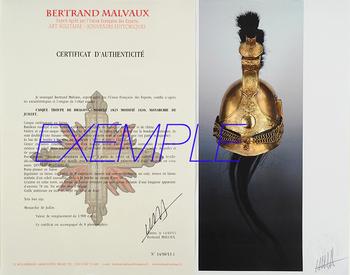
Next update Friday, december 12 at 13:30 PM
FOR ALL PURCHASES, PAYMENT IN MULTIPLE CHECKS POSSIBLE
bertrand.malvaux@wanadoo.fr 06 07 75 74 63
SHIPPING COSTS
Shipping costs are calculated only once per order for one or more items, all shipments are sent via registered mail, as this is the only way to have proof of dispatch and receipt.
For parcels whose value cannot be insured by the Post, shipments are entrusted to DHL or Fedex with real value insured, the service is of high quality but the cost is higher.
RETURN POLICY
Items can be returned within 8 days of receipt. They must be returned by registered mail at the sender's expense, in their original packaging, and in their original condition.
AUTHENTICITY
The selection of items offered on this site allows me to guarantee the authenticity of each piece described here, all items offered are guaranteed to be period and authentic, unless otherwise noted or restricted in the description.
An authenticity certificate of the item including the description published on the site, the period, the sale price, accompanied by one or more color photographs is automatically provided for any item priced over 130 euros. Below this price, each certificate is charged 5 euros.
Only items sold by me are subject to an authenticity certificate, I do not provide any expert reports for items sold by third parties (colleagues or collectors).
FOR ALL PURCHASES, PAYMENT IN MULTIPLE CHECKS POSSIBLE
bertrand.malvaux@wanadoo.fr 06 07 75 74 63
An authenticity certificate of the item including the description published on the site, the period, the sale price, accompanied by one or more color photographs is automatically provided for any item priced over 130 euros. Below this price, each certificate is charged 5 euros.
Only items sold by me are subject to an authenticity certificate, I do not provide any expert reports for items sold by third parties (colleagues or collectors).
